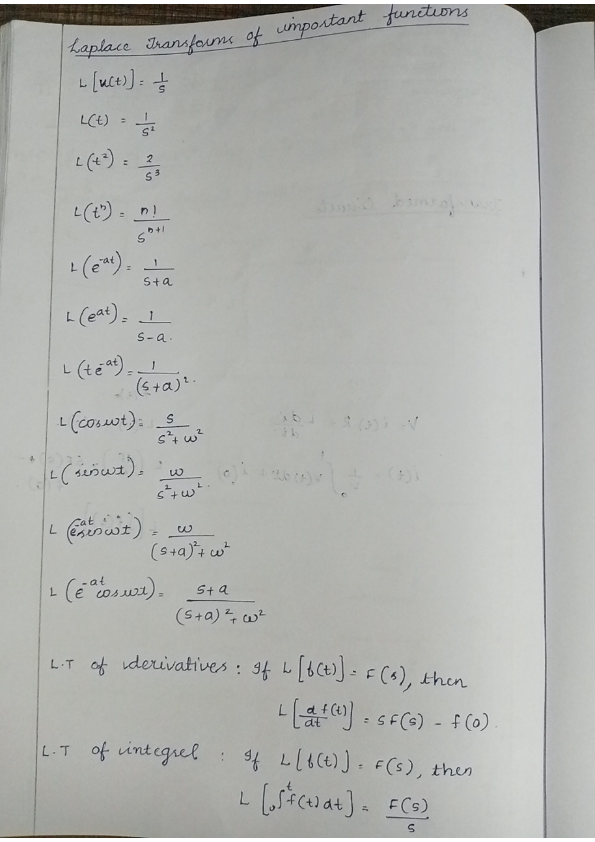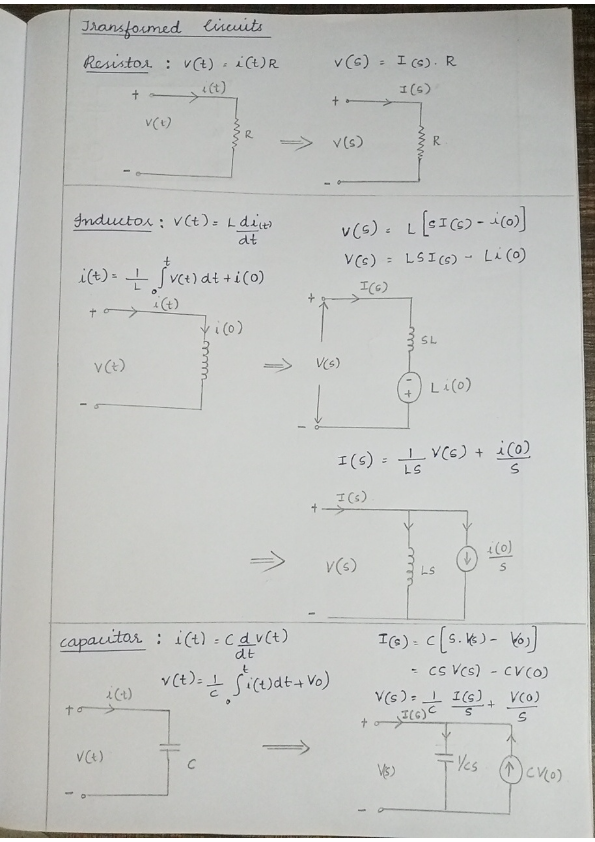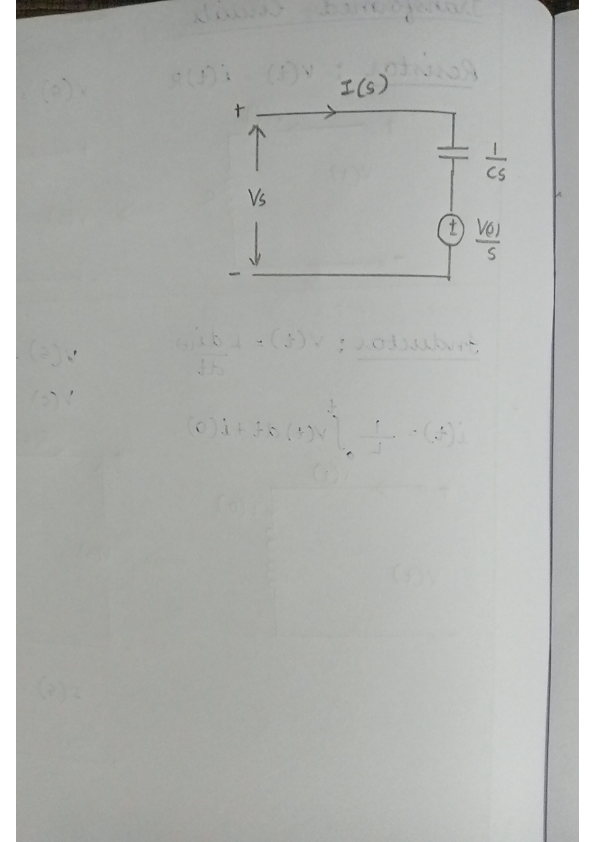Laplace Transform Techniques in Circuit Analysis
Laplace Transforms of Important Functions

Basic Laplace Transforms
-
Unit Step Function:
- The unit step function is often used to model systems that switch on at a specific time.
-
Constant Function:
- Represents a constant rate or acceleration in a system.
-
Polynomial Functions:
- General form:
- Useful for analyzing free response of systems and solving differential equations involving polynomials.
-
Exponential Decay:
- Models processes like radioactive decay and cooling.
-
Exponential Growth:
- Used in contexts like population growth or compounding interest.
-
Exponential Times Polynomial:
- Useful in more complex system responses involving time-delay effects.
Trigonometric Functions
-
Cosine Function:
- Describes oscillatory systems, such as electrical circuits or mechanical vibrations.
-
Sine Function:
- Similar applications to cosine, often used with initial conditions.
-
Damped Sine Wave:
- Models systems where oscillation amplitude decreases over time, like shock absorbers.
-
Damped Cosine Wave:
- Applies to damped oscillatory systems.
Derivatives and Integrals
-
Derivatives:
- If , then:
- The derivative formula links the time domain to the s-domain by introducing a multiplicative factor and accounting for initial conditions.
-
Integrals:
- If , then:
- Integration in the Laplace domain corresponds to division by , useful for solving differential equations with integral terms.
These Laplace transform relationships are essential tools for engineers and scientists to analyze and solve linear time-invariant systems, especially in control systems, signal processing, and differential equations. They simplify the handling of complex systems by converting differential equations into algebraic ones.
Extended readings:
Transformed Circuits

Resistor
-
Equation:
- A resistor follows Ohm's Law, where the voltage across the resistor is directly proportional to the current through it, multiplied by its resistance .
-
Laplace Transform:
- In the Laplace domain, the transformation simplifies the analysis of linear time-invariant systems. The impedance of a resistor remains .
-
Circuit Representation:
- Original: A simple resistor with input voltage and current .
- Transformed: Resistor with impedance and input current .
Inductor
-
Equation:
- The voltage across an inductor is proportional to the rate of change of current through it, scaled by inductance .
-
Laplace Transform:
- These transformations account for the initial current , showing how the inductance's stored energy affects current and voltage over time.
-
Circuit Representation:
- Original: An inductor with initial current .
- Transformed: Inductor in series with a voltage source .
Capacitor
-
Equation:
- The current through a capacitor is proportional to the rate of change of voltage across it, determined by the capacitance .
-
Laplace Transform:
- These equations highlight how a capacitor initially charged to affects system behavior in the Laplace domain.
-
Circuit Representation:
- Original: A capacitor with initial voltage .
- Transformed: Capacitor in parallel with a voltage source .
Insights:
-
Laplace Transformation: A mathematical tool used to convert differential equations into algebraic equations, making complex systems easier to handle, especially for control systems and signal processing.
-
Impedance in s-domain: For analysis in the Laplace domain, resistors, inductors, and capacitors are treated with their respective impedances , , and .
-
Initial Conditions: When transforming to the -domain, initial conditions are crucial as they represent the stored energy in capacitors and inductors, influencing system response.
Extended readings:
LAPLACE CIRCUIT ANALYSIS NOTES

Circuit Diagram
Description
- Components:
- Current Source: .
- Capacitor: .
- Voltage Source: .
- Current: .
Insights
- Laplace Transform: The use of and indicates the application of Laplace transforms to circuit analysis, a powerful method to handle circuits in the s-domain.
- Complex Frequency: The variable represents complex frequency, , where is the growth rate and is the oscillation.
Additional Concepts
Capacitive Reactance
- Reactance in S-Domain:
- Represents how a capacitor behaves as an impedance in the s-domain, inversely proportional to both the capacitance and .
Initial Conditions
- Initial Charge or Current:
- The term suggests an initial voltage, which is transformed from the time domain to the s-domain, accommodating initial conditions directly in Laplace analysis.
Analysis Strategy
- Use Kirchhoff’s laws in the s-domain to set up equations involving voltage and current.
- Solve algebraically for desired quantities, such as node voltages or branch currents, using known transforms.
- Convert back to the time domain using inverse Laplace transform, if necessary.
Example Application
-
Find in terms of known quantities:
- Write the equation using KVL or KCL in the domain.
- Example:
- Solve for .
-
Time-Domain Analysis:
- Use inverse Laplace transform to revert known quantities back to the time domain.
- Apply initial conditions where applicable to determine specific solutions in physical time.
General Tips
- Make sure to account for all initial conditions due to their impact on the s-domain equations.
- Familiarize yourself with standard Laplace transforms and their inverses, as they simplify solving differential equations.
Extended readings: